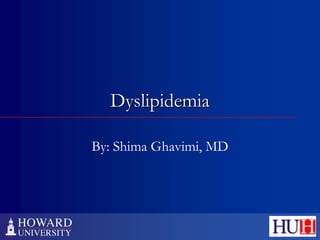
Dyslypedia
- 2. dyslipidemia MI is the most common cause of death in the U.S Stroke is the third common cause of death in the U.S There is significant overlap in the risk factors for stroke and MI and among these RF one of them is hyperlipidemia
- 3. The first set of cholesterol guidelines (ATP I) focused on the primary prevention of CHD, outlining a strategy for cholesterol lowering goals in individuals with high cholesterol and two or more cardiovascular risks. At that time, an LDL-C of greater than 160 was chosen as abnormal because cardiovascular risk increased steeply above this level (as a result, 25% of the population was labeled with "high cholesterol"). The second set of guidelines added goals for secondary prevention in patients with established CHD. ATP III (and the revised ATP IIIR) combined the assessment of risk factors for CHD (including prior CHD or CHD "risk equivalent" conditions) with aggressive lipid lowering goals. An LDL-C of less than 130mg/dl was defined as "desirable" and an LDL-C of less than 100mg/dl was "optimal". An even more aggressive target LDL-C of less than 70mg/dl was defined for those at highest risk. Based on the number of cardiovascular risks or risk-equivalent conditions, goal LDL-C was defined as less than 130mg/dl, less than 100mg/dl, or less than 70mg/dl according to the amount of risk for an individual. Many have referred to this management principle of ATP guidelines as "treat to target". With ATP III/IIIR guidelines, many began to default to the management principle that "lowest is best", assuming that additional CVD benefit would result from attaining the most aggressive lipid lowering goals.
- 4. ATP I-IIIR built an increasingly aggressive argument for lipid management. ATP IV similarly builds on the foundation of prior guidelines, but also represents a significant change in management of hyperlipidemia. Gone is the concept of "treat to target". Treat to target was abandoned because of the lack of evidence of a specific target and lack of comparison data on different targets. In its stead, the intensity of lipid lowering becomes the focus. Also new: broadening of the guideline focus from coronary heart disease (CHD) to atherosclerotic cardiovascular disease (ASCVD)(i.e., including coronary artery disease, cerebrovascular disease, and peripheral artery disease); broadening of risk assessment for primary prevention; definition of new treatment benefit groups. Gone from ATP guidelines are lipid lowering targets and metabolic syndrome treatment targets. Finally, included in ATP IV are considerations of the potential adverse effects of therapy.
- 7. ASCVD Acute coronary syndrome Prior myocardial infarction Stable/unstable angina Prior coronary or arterial revascularization Stroke Transient ischemic attack Peripheral arterial disease presumed to be of atherosclerotic origin
- 8. asymptomatic atherosclerosis noted incidentally on imaging the presence of an abdominal aortic aneurysm is not included.
- 9. + + LDL-C >190mg/dl Individuals with very high LDL-C (i.e., >190mg/dl) are known to be at significant risk of an ASCVD event regardless of other risk factors. As a result, primary LDL-C elevations >190mg/dl are an indication for statin treatment in all individuals 21 and older; there is no need to calculate ASCVD risk in this group. Before initiating treatment, secondary causes of LDL-C should be excluded.
- 11. Diabetes All patients aged 40-75 with diabetes benefit from lipid lowering therapy. Decisions on lipid lowering therapy in younger and older individuals outside this age range should be made on an individual basis. Although all diabetic patients aged 40-75 should be treated with lipid-lowering therapy, the intensity of treatment is determined by their 10-year risk of an ASCVD event. Therefore, in patients with diabetes between 40-75, we always calculate the 10-year risk of ASCVD to determine the intensity of management.
- 12. As a reminder, we do not need to perform this ASCVD risk calculation in those with clinical ASCVD or LDL-C>190mg/dl, but do use this calculation in other patients, including those with diabetes. The guidelines limit their recommendations in this group to those aged 40-75, leaving to individual judgment the role of risk calculation for younger and older individuals. The only statin benefit group with specific recommendations on younger individuals is those with LDL-C>190mg/dl, in whom we start treatment at age 21.
- 13. There were two clinical groups in whom the benefit of lipid lowering therapy was not demonstrated: those with New York Heart Association (NYHA) Class II-IV heart failure and those who were receiving hemodialysis. The benefit of lipid-lowering drugs in these groups remains unclear.
- 18. When evaluating for screening, we consider patients to be at higher risk if they have more than one risk factor (hypertension, smoking, family history) or a single risk factor that is severe. We then decide whom to screen based on risk factors, age, and sex •In primary prevention patients who are at higher risk, we suggest screening for lipid abnormalities starting at age 25 in male patients and age 35 in female patients •In primary prevention patients who are not at higher risk, we suggest screening for lipid abnormalities starting at age 35 in male patients and age 45 in female patients.
- 19. In patients where lipid measurement is indicated, we suggest repeating measurements every five years in patients whose prior lipid measurement places them clearly below an appropriate threshold for treatment. In patients near a threshold for treatment (whether based on total CV risk or an LDL-C goal), we suggest repeating measurements every three years. We also repeat measurements at least every three years in those found to be at increased CV risk based on their lipid measurements
